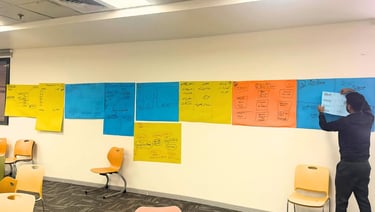
How can students learn from Walls: Notes From a Smart Workshop at WAAD Academy
This article shares insights from a workshop at WAAD ACADEMY, where the Head of Learning Mr. Ibrahim Mekkawy introduced the idea of turning classroom walls into active learning spaces through interactive boards. The session, under the supervision of School Principal Mr. Faris Nagadi, reflected WAAD’s vision of crafting global mindsets and preparing students as independent learners through innovative teaching practices.
Mr. Shayan Siddiqui
8/25/20254 min read


I had the chance to attend a hands-on workshop at Waad Academy Schools led by Ibrahim Mekkawy and held under the guidance of Faris Nagadi, NPQSL .The core idea was simple, turn the classroom walls and boards into living teachers. Not posters for decoration tools that help students think, check understanding, and take the next step.
Why Independent Learners Matter
Students won’t always have a teacher beside them. Life asks them to spot problems, plan steps, and judge the quality of their own work. That is student agency, a student’s capacity to set goals, act with purpose, and improve based on feedback. The OECD’s Learning Compass places agency at the heart of future-ready learning because it helps young people guide themselves in new situations, not just follow instructions. (OECD)
Independent learners also learn more. Strategies that build self-regulation and metacognition (planning, monitoring, evaluating one’s learning) are linked with around eight months of extra progress in a year, on average, in the EEF evidence base. (EEF)
Why Walls and Boards Should Teach
A well-designed wall or board makes thinking visible. It shows where we are in the unit, what success looks like, how to get there, and how to improve. This keeps help within arm’s reach and reduces constant “What do I do now?” questions.
Feedback that moves learning forward sits at the center. Feedback is one of the highest-impact factors in John Hattie’s synthesis of over a thousand studies (effect size = 0.70). (VISIBLE LEARNING)
Assessment for Learning (AFL) from Cambridge is clear: use ongoing checks and shared success criteria so students and teachers can take the next step in the moment, not weeks later. (Cambridge International)
When the wall carries the success criteria, models, and “next step” prompts, students don’t wait for the teacher to circulate, they self-correct and try again.
Why Interactivity Matters
An interactive board or wall is not a slideshow. It is a feedback system. Students interact, see what “good” looks like, compare with their own attempt, and get a nudge for the next draft.
What helps most: clear goals, timely cues, and quick chances to apply feedback. The EEF’s toolkit on feedback reports around five months of additional progress when done well. (EEF)
What to avoid: generic praise, cluttered displays, or static posters that never change.
How Teaching Is Evolving (And Where This Fits)
Modern classrooms lean on practices that raise thinking and independence:
Inquiry-based learning to spark curiosity and concept understanding (central in the IB across PYP/MYP/DP). (International Baccalaureate®)
Active learning & AfL as core Cambridge approaches students do the heavy cognitive lifting while teachers check understanding in real time. (Cambridge International.
Metacognition and self-regulation to help students plan, monitor, and evaluate their learning (8 months average impact). (EEF)
Learning walls and interactive boards sit right at this intersection. they make inquiry, AFL, and metacognition visible and routine.
Why Inquiry Keeps Gaining Ground
Inquiry matters because it builds conceptual understanding, not only recall. IB frames teaching as based on inquiry, concept-focused, informed by assessment, and differentiated, all habits that fit a world that changes fast.
Evidence also gives a caution: open inquiry without enough support can be uneven. John Hattie’s synthesis places inquiry-based teaching near the “average” zone unless it is structured with clear goals and feedback. In short, guided inquiry beats guesswork. (VISIBLE LEARNING)
“Scaffolding,” Not “Car Folding”
Teachers often call the step-by-step support scaffolding, temporary help that fades as students gain skill. In Hattie’s list, scaffolding scores very highly (0.82), which explains why structured prompts on the walls and boards pay off. (VISIBLE LEARNING)
What An Interactive Learning Wall/Board Looks Like
1) Direction
Unit roadmap with today’s learning goal in plain language.
Success criteria in student-friendly bullets, not jargon.
2) Models
Annotated exemplar (good, better, best) with callouts.
Live “mistake of the week” to normalize improvement.
3) Feedback Loops
Quick “Check your work” box: 3–4 yes/no checks.
Space for exit tickets; yesterday’s trends inform today’s starter
4) Thinking Tools
Graphic organizers that match the subject (e.g., claim-evidence-reasoning, number lines, lab report frame).
Word banks and sentence stems for talk and writing.
5) Student Voice (Specific for Business Studies)
“What happened this week in NewYork Stock Exchange?
Student-made mini-posters that teach a micro-skill to peers.
A 10-Minute Setup You Can Repeat
Step 1: Goal and Criteria Write the Week's or Terms goal and 3 success checks.
Step 2: Model and Contrast Pin one strong sample and one “almost there,” both annotated.
Step 3: Try-Check-Tweak Students attempt a short task, compare to the model, apply one tweak, and initial the tweak on their paper.
Step 4: Exit Note Collect one sentence: “My next step is…”. Use these to update tomorrow’s wall.
This cycle builds agency and keeps feedback fast. It also mirrors IB’s “inquiry–action–reflection” and Cambridge’s AFL emphasis on next steps. (International Baccalaureate®, Cambridge International)
Why This Is Timely In The Gulf
As an Educational consultant, I have visited numerous schools and I can confidently say that schools across the region are pushing for global mindsets while honoring local identity. WAAD Academy’s vision aligns with that aim. The wall and board approach respects culture and language, yet raises the bar for independence, feedback, and quality work. It is practical, not costly, and it scales across subjects.
A Short Checklist For Teachers
Post weekly or term's goal and success criteria where eyes actually go.
Keep models at hand height; add arrows that explain why they work.
Build self-check boxes students can use without help.
Rotate student work weekly to show growth, not perfection.
Close each lesson with one-minute reflection; feed it into tomorrow’s wall.
Fade the prompts over time to grow independence (scaffolding that comes down).
My Perspective About The Workshop
The workshop at WAAD Academy felt fresh, interactive, and well designed. More than a neat idea, it is a system for daily clarity and feedback. It supports IB inquiry, fits Cambridge AfL, and most of all helps students learn how to learn.
References You Can Share With Colleagues
Education Endowment Foundation (EEF): Feedback (avg. +5 months). (EEF)
EEF: Metacognition and self-regulation (avg. +8 months). (EEF)
Hattie, Visible Learning: effect sizes for feedback (~0.70) and scaffolding (~0.82). (VISIBLE LEARNING)
IB: Inquiry across programmes; ATL skills and inquiry-driven teaching. (International Baccalaureate®)
Cambridge International: Active learning and Assessment for Learning resources. (Cambridge International)
OECD Learning Compass 2030: student agency concept. (OECD)